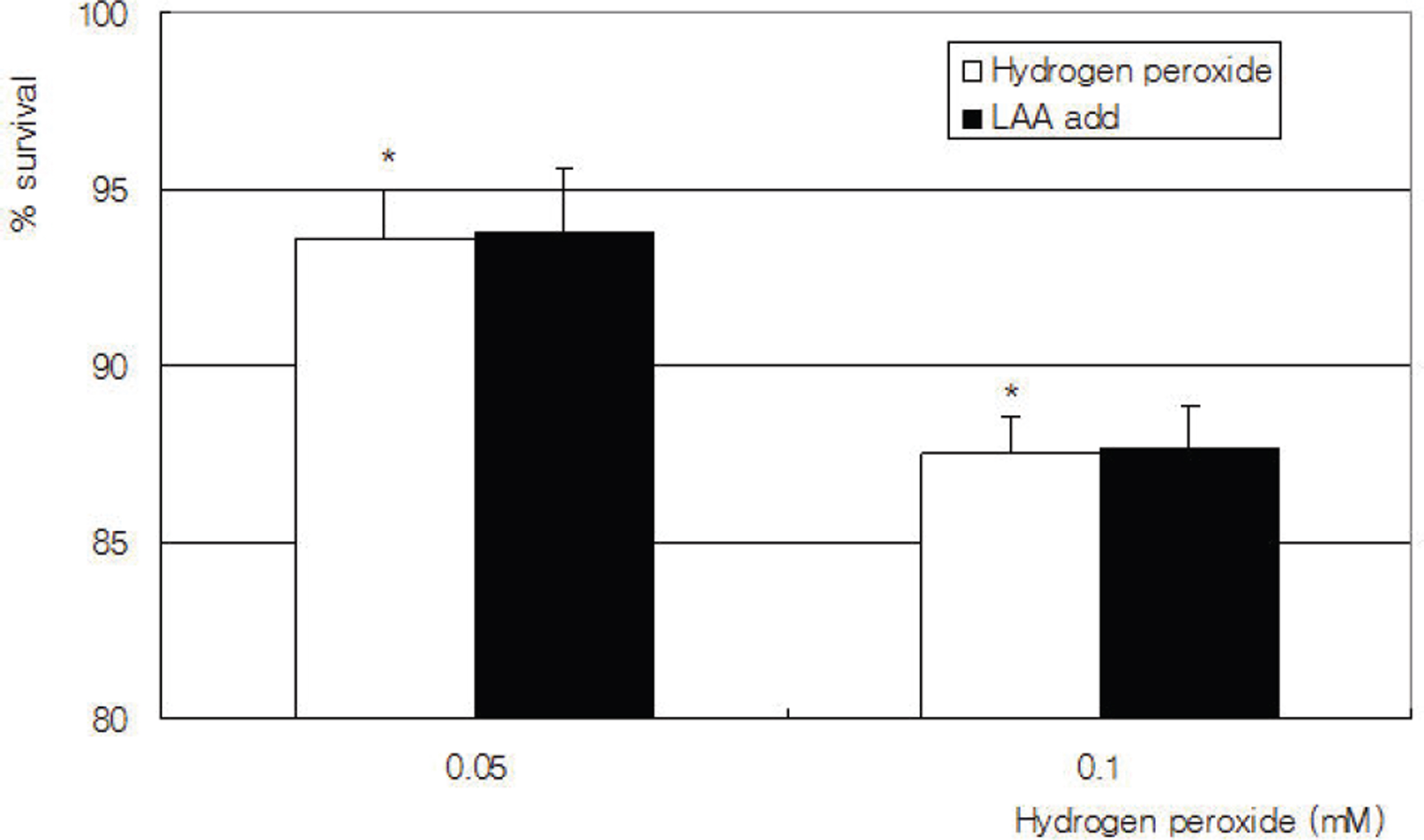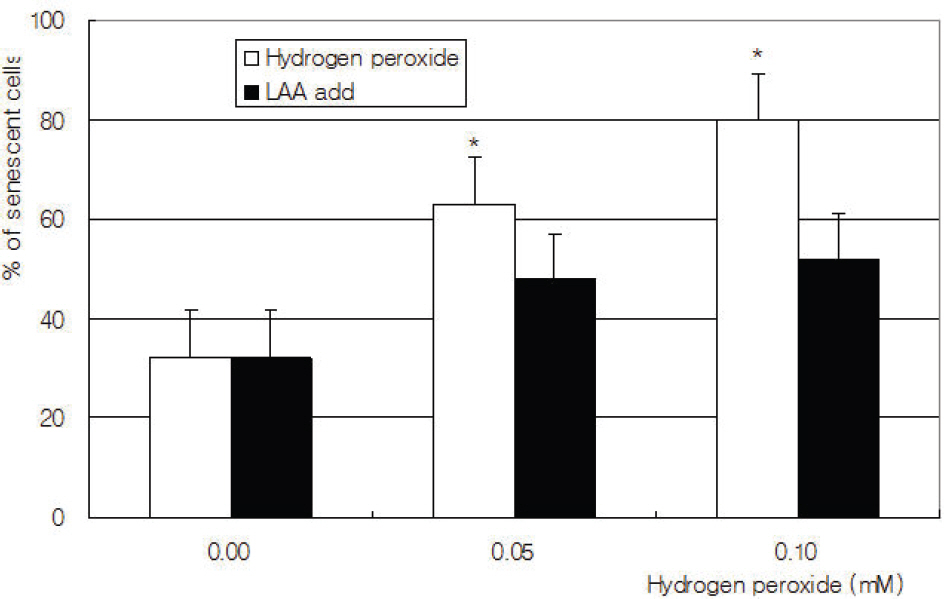J Korean Ophthalmol Soc.
2008 Oct;49(10):1665-1670.
Effect of Hydrogen Peroxide-induced Oxidative Stress on the Senescence of Trabecular Meshwork Cells
- Affiliations
-
- 1Department of Ophthalmology, Catholic University of Daegu School of Medicine, Daegu, Koera. jwkim@cu.ac.kr
Abstract
- PURPOSE
To investigate the effects of oxidative stress on the senescence of trabecular meshwork (TM) cells and the effect of L-ascorbic acid (LAA) against oxidative stress-induced senescence.
METHODS
Primary cultured human TM cells were exposed to 0.05 or 0.1 mM hydrogen peroxide for 30 minutes and incubated for 1 week with or without co-exposure of LAA. Cellular survival, nitrite production, and senescence were assessed with MTT, Griess, and SA-beta-gal assays, respectively.
RESULTS
Hydrogen peroxide decreased cellular survival and NO production accompanied increased cellular senescence. LAA did not prevent hydrogen peroxide-induced senescence.
CONCLUSIONS
Oxidative stress-induced senescence of TM cells may be related to the dysfunction of trabecular meshwork in glaucoma.
MeSH Terms
Figure
Reference
-
References
1. Becker B. Chemical composition of human aqueous humor. Effects of acetazolamide. Arch Ophthalmol. 1957; 57:793–800.
Article2. Zhou L, Li Y, Yue BY. Oxidative stress affects cytoskeletal structure and cell-matrix interactions in cells from an ocular tissue: The trabecular meshwork. J Cell Physiol. 1999; 180:182–9.
Article3. Sacca SC, Pascotto A, Camicione P. . Oxidative DNA damage in the human trabecular meshwork. Arch Ophthalmol. 2005; 123:458–63.
Article4. Liton PB, Challa P, Stinnett S. . Cellular senescence in the glaucomatous outflow pathway. Exp Gerontol. 2005; 40:745–8.
Article5. Yamazaki Y, Matsunaga H, Nishikawa M. . Senescence in cultured trabecular meshwork cells. Br J Ophthalmol. 2007; 91:808–11.
Article6. Green LC, Wagner DA, Glogoski J. . Analysis of nitrate, nitrite and [15N] nitrate in biologic fluids. Anal Biochem. 1982; 126:131–8.7. Matsunaga H, Handa JT. . β-galactosi dase histochemistry and telomere loss in senescent retinal pigment epithelial cells. Invest Ophthalmol Vis Sci. 1999; 40:197–202.8. Dimri GP, Lee X, Basilr G. . A biomarker that identifies senescent human cells in culture and in aging skin in vitro. Proc Natl Acad Soc U S A. 1995; 92:9363–7.9. Polansky JR, Weinreb RN, Baxter JD, Alvarado J. Human trabecular cells. I. Establishment in tissue culture and growth characteristics. Invest Ophthalmol Vis Sci. 1979; 18:1043–9.10. Alvarado JA, Wood I, Polansky JR. Human trabecular cells. II. Growth pattern and ultrastructural characteristics. Invest Ophthalmol Vis Sci. 1982; 23:464–78.11. Chen JZ, kadlubar FF. A new clue to glaucoma pathogenesis. Am J Med. 2003; 114:697–8.
Article12. Ko ML, Hu DN, Ritch R, Sharma SC. The combined effect of brain-derived neurotrophic factor factor and free radical scavenger in experimental glaucoma. Invest Ophthalmol Vis Sci. 2000; 41:2967–71.13. Izzotti A, Sacca SC, Cartiglia C. De Flora S. Oxidative deoxyribonucleic acid damage in the eyes of glaucoma patients. Am J Med. 2003; 114:638–46.14. Ferreira SM, Lerner SF, Brunzini R. . Oxidative stress markers in aqueous humor of glaucoma patients. Am J Ophthalmol. 2004; 137:62–9.
Article15. Padgaonkar V, Giblin FJ, Leverenz V. . Studies of H2 O2-induced effects on cultured bovine trabecular meshwork cells. J Glaucoma. 1994; 3:123–31.16. Erb C, Nau-Staudt K, Flammer J, Nau W. Ascorbic acid as a free radical scavenger in porcine and bovine aqueous humor. Ophthalmic Res. 2004; 36:38–42.17. Ross R. Atherosclerosis-an inflammatory disease. N Eng J Med. 1999; 340:115–26.18. Heller R, Münscher-Paulig F, Gräbner R, Till U. L-ascorbic acid potentiates nitric oxide synthesis in endothelial cells. J Biol Chem. 1999; 274:8254–60.
Article19. May JM. How does ascorbic acid prevent endothelial dysfunction? Free Radic Biol Med. 2000; 28:1421–9.
Article20. Huang A, Vita JA, Venema RC, Keaney Jr. Ascorbic acid enhances endothelial nitric-oxide synthase activity by increasing intracellular tetrahydrobiopterin. J Biol Chem. 2000; 275:17399–406.
Article21. Heller R, Unbehaun A, Schnellenberg B. . L-ascorbic acid potentiates endothelial nitric oxide synthesis via a chemical stabilization of tetrahydrobiopterin. J Biol Chem. 2001; 276:40–7.
Article22. Vasa M, Breitschopf K, Zeiher AM, Dimmeler S. Nitric oxide activates telomerase and delays endothelial cell senescence. Circ Res. 2000; 87:540–2.
Article23. Zhou L, Li Y, Yue BY. Oxidative stress affects cytoskeletal structure and cell-matrix interactions in cells from ocular tissue: the trabecular meshwork. J Cell Physiol. 1999; 180:182–9.24. Alvarado J, Murphy C, Juster R. Trabecular meshwork cellularity in primary open-angle glaucoma and nonglauco matous normals. Ophthalmology. 1984; 91:564–79.25. Millard CB, Tripathi BJ, Tripathi RC. Age-related changes in protein profiles of the normal human trabecular meshwork. Exp Eye Res. 1987; 45:623–31.
Article26. Schchschabel DO, Binninger E. Aging of trabecular meshwork cells of the human eye in vitro. Z Gerontol. 1990; 23:133–5.27. Horstmann HJ, Rohen JW, Sames K. Age-related changes in the composition of proteins in the trabecular meshwork of the human eye. Mech Ageing Dev. 1983; 21:121–36.
Article28. Kurz DJ, Decary S, Hong Y. . Chronic oxidative stress compromises telomere integrity and accelerates the onset of senescence in human endothelial cells. J Cell Sci. 2004; 117:2417–26.
Article29. von Zglinicki T. Role of oxidative stress in telomere length regulation and replicative senescence. Ann N Y Acad Sci. 2000; 908:99–110.
Article30. Wei YH. Oxidative stress and mitochondrial DNA mutations in human aging. Proc Soc Exp Biol Med. 1998; 217:53–63.
Article31. Kim JW. Ascorbic acid enhances nitric oxide production in cultured trabecular meshwork cell. Korean J Ophthalmol. 2005; 19:297–31.32. Furumoto K, Inoue E, Nagao N. . Age-dependent telomere shortening is slowed down by enrichment of intracellular vitamin C via suppression of oxidative stress. Life Sci. 1998; 63:935–48.
Article33. Roques SC, Landrault N, Teisse’dre P. . Hydrogen peroxide generation in Caco-2 cell culture medium by addition of phenolic compounds: Effect of ascorbic acid. Free Radic Res. 2002; 36:593–9.
Article
- Full Text Links
- Actions
-
Cited
- CITED
-
- Close
- Share
- Similar articles
-
- Effect of Ascorbic Acid Against the Oxidative Stress-Induced Cellular Senescence in Trabecular Meshwork Cells
- Role of Ascorbic Acid Against the Oxidative Stress in Trabecular Meshwork Cells
- Ascorbic Acid Enhances Nitric Oxide Production in Trabecular Meshwork Cells
- Effect of Hydrogen Sulfide on the Oxidative Stress and Senescence inTrabecular Meshwork Cells
- Effect of Ginkgo Biloba Extract on the Survival of Cultured Human Trabecular Meshwork Cells





